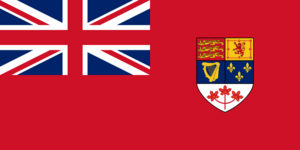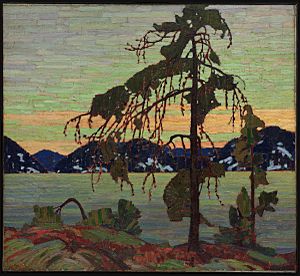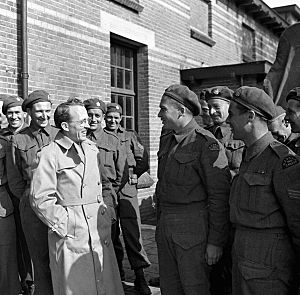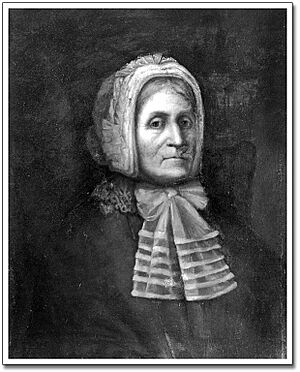English Canadians facts for kids
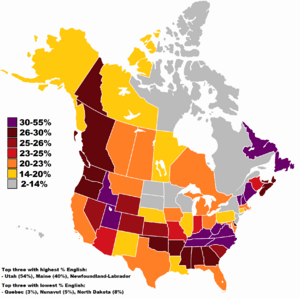
English Americans and English Canadians as percent of population by state and province.
|
|
| Total population | |
|---|---|
| 6,263,880 (by ancestry) 17.2% of the total Canadian population (2021) c. 31.63 million (English-speaking Canadians) 87.1% of the total Canadian population (2021) |
|
| Regions with significant populations | |
| Throughout Canada, minority in Quebec | |
| Languages | |
| English | |
| Related ethnic groups | |
| English Americans and other English diaspora, Scottish Canadians and other British Canadians, Old Stock Canadians |
English Canadians are people in Canada who are of English background or who speak English. They are often talked about in contrast to French Canadians, who speak French. Canada is a country with two official languages: English and French. People who move to Canada often join one of these language groups. But they also keep parts of their original cultures.
Many English-speaking Canadians have family roots in England or other parts of the British Isles. However, English-speaking Canadians come from many different backgrounds. Their families came from various parts of Europe, Asia, Africa, and the Americas. They also include people from French Canada and Indigenous groups.
Besides "English Canadian," people also use "Anglophone Canadian" or "Anglo-Canadian." Many Canadians also describe their background as simply "Canadian." A lot of these people might also have English ancestors. English Canadians are part of a larger group called British Canadians. This group is part of European Canadians.
Contents
A Look at English Canadian History
| Ethnic English Canadian Population History |
||
|---|---|---|
| Year | Pop. | ±% |
| 1871 | 706,369 | — |
| 1881 | 881,301 | +24.8% |
| 1901 | 1,260,899 | +43.1% |
| 1911 | 1,871,268 | +48.4% |
| 1921 | 2,545,358 | +36.0% |
| 1931 | 2,741,419 | +7.7% |
| 1941 | 2,968,402 | +8.3% |
| 1951 | 3,630,344 | +22.3% |
| 1961 | 4,195,175 | +15.6% |
| 1971 | 6,247,585 | +48.9% |
| 1981 | 7,060,470 | +13.0% |
| 1986 | 9,311,910 | +31.9% |
| 1991 | 8,624,900 | −7.4% |
| 1996 | 6,982,320 | −19.0% |
| 2001 | 6,129,460 | −12.2% |
| 2006 | 6,973,930 | +13.8% |
| 2011 | 7,085,530 | +1.6% |
| 2016 | 6,964,780 | −1.7% |
| 2021 | 6,263,880 | −10.1% |
| Source: Statistics Canada Note1: 1981 Canadian census did not include multiple ethnic origin responses, thus population is an undercount. Note2: 1996-present census populations are undercounts, due to the creation of the "Canadian" ethnic origin category. |
||
Early Settlements in Newfoundland
English Canadian history began with attempts to settle Newfoundland. This happened in the 1500s. The first English settlement in what is now Canada was in St. John's, Newfoundland, in 1583. Many people from Ireland and England moved to Newfoundland. This was often because of the fishing industry. Newfoundland and Labrador was the last province to join Canada in 1949.
Nova Scotia's English Roots
In the 1700s, Britain and France fought over the area now called Nova Scotia. British forces took French settlements like Port Royal and Louisbourg. After a treaty in 1713, Britain gained control of Acadia. This area is now mainland Nova Scotia and New Brunswick.
In 1749, Colonel Edward Cornwallis led an expedition to settle Chebucto. Many of these settlers were from London, England. Cornwallis's settlement, Halifax, became the capital. It was also a key British military base. To balance the French Catholic population, German Protestants were given land. They founded Lunenburg. Nova Scotia also saw many Scottish immigrants arrive later.
Loyalists Shape New Brunswick, Quebec, and Ontario
The history of English Canadians is linked to English settlement in North America. Many Loyalists moved to Canada after the American Revolution. These Loyalists were loyal to Britain. About 50,000 Loyalists resettled north of the United States after 1783. Many had lived in North America for generations. They came from important families in cities like Boston and New York.
These settlers were mostly of British background. But they also included people with French and Dutch ancestors. Loyalists of African descent also came with them. They settled mainly in southern Nova Scotia and along the Saint John River. They also settled in Quebec, near Montreal.
The colony of New Brunswick was created for these new English-speaking settlers. The Loyalist settlements in southwestern Quebec became the start of Upper Canada. This area later became Ontario after 1867.
Ontario's Growth and Diversity
Ontario was a main destination for English, Scottish, and Scots-Irish settlers in the 1800s. It was also a battleground during the War of 1812 against the United States. The province also welcomed immigrants from Germany. Many settled around Kitchener. Ontario became the most populated province when Canada was formed. It became a major industrial and cultural center for English Canada. Today, Toronto is Canada's largest city. It is also one of the most multicultural cities in the world. This is due to changing immigration patterns since the 1960s.
English Speakers in Quebec
After Britain took over New France in 1759, a British ruling class formed in Quebec City. More English-speaking settlers arrived in the Eastern Townships and Montreal after the American Revolution. English, Scottish, and Irish communities grew in Montreal in the 1800s. Montreal became Canada's largest city and business center.
An English-Scottish business group controlled Canadian trade until the 1950s. They founded Protestant schools, hospitals, and universities like McGill University. Other Europeans, like Italians and Jews, joined these immigrants in the early 1900s. Many of them became part of the English-speaking community.
Many English-speaking Quebeckers left Quebec after the Parti Québécois was elected in 1976. This led to a big drop in the English-speaking population. Many who stayed learned French to live in the French-speaking society.
British Columbia's Pacific Connection
Many early European communities in British Columbia started as trading posts. These were set up by the Hudson's Bay Company. The company was founded in London in 1670 for the fur trade. More people began to settle when Fort Victoria was founded in 1843. The Colony of Vancouver Island was created in 1849. The capital, Victoria, grew during the height of the British Empire. It was known for being very "English."
The Colony of British Columbia was formed on the mainland in 1858. Governor James Douglas created it to show British control. This was important because many American gold miners were arriving. British Columbia joined Canada in 1871. It chose to be Canadian to avoid possibly becoming part of the United States.
Chinese workers helped build the Canadian Pacific Railway. They formed large communities in B.C., especially in Vancouver. Vancouver quickly became the province's economic and cultural center. British Columbia has welcomed immigrants from many countries. This includes Germans, Scandinavians, Italians, and Sikhs from India. Many Chinese immigrants also arrived from Hong Kong, Taiwan, and mainland China. For many years, British Columbia received more immigrants from Great Britain than other provinces.
Prairies: Alberta, Manitoba, and Saskatchewan
French-English tensions also played a role in the Prairies. The first British settlement in Assiniboia (now part of Manitoba) involved about 300 Scottish colonists. This was led by Lord Selkirk in 1811. After some conflicts, the Canadian government settled Manitoba, Saskatchewan, and Alberta. These provinces became largely English-speaking in culture. However, many immigrants from non-English European backgrounds also arrived. These included many Scandinavians and Ukrainians.
English Canadians in the 20th Century
Canada has a history of peace. But war has also shaped English Canadian identity. As part of the British Empire, Canada joined World War I in 1914. English Canadians were very eager to serve. Their bravery at battles like Vimy Ridge helped create a stronger sense of Canadian identity. In World War II, Canada declared war on its own. It played a key role in supporting the Allied war effort. English Canadians strongly supported defending the United Kingdom. They also helped free Europe from Axis control.
After the wars, Canada joined NATO. English Canadians were proud when Lester Pearson won the Nobel Prize for Peace. He helped solve the Suez Crisis. English Canadians have also strongly supported United Nations peacekeeping efforts.
In the late 1900s, American culture became more influential. British influence lessened. Political issues, like the Quebec sovereignty movement, caused some identity questions for English Canadians. Writers like Margaret Atwood and Robertson Davies explored the English Canadian experience. Journalist Pierre Berton wrote popular books about Canadian history. These books were very popular among English-speaking Canadians.
How Many English Canadians?
Note1: 1981 Canadian census did not include multiple ethnic origin responses, thus population is an undercount.
Note2: 1996-present census populations are undercounts, due to the creation of the "Canadian" ethnic origin category.
Note1: 1981 Canadian census did not include multiple ethnic origin responses, thus population is an undercount.
Note2: 1996-present census populations are undercounts, due to the creation of the "Canadian" ethnic origin category.
Population Numbers
| Year | Population | % of total population |
|---|---|---|
| 1871 |
706,369 | 20.264% |
| 1881 |
881,301 | 20.378% |
| 1901 |
1,260,899 | 23.475% |
| 1911 |
1,871,268 | 25.966% |
| 1921 |
2,545,358 | 28.964% |
| 1931 |
2,741,419 | 26.419% |
| 1941 |
2,968,402 | 25.797% |
| 1951 |
3,630,344 | 25.914% |
| 1961 |
4,195,175 | 23.002% |
| 1971 |
6,247,585 | 28.967% |
| 1981 |
7,060,470 | 29.317% |
| 1986 |
9,311,910 | 37.215% |
| 1991 |
8,624,900 | 31.951% |
| 1996 |
6,982,320 | 24.475% |
| 2001 |
6,129,460 | 20.68% |
| 2006 |
6,973,930 | 22.323% |
| 2011 |
7,085,530 | 21.568% |
| 2016 |
6,964,780 | 20.211% |
| 2021 |
6,263,880 | 17.242% |
Where English Canadians Live
This information comes from Statistics Canada, 2021.
Provinces and Territories
| Province / Territory | Percent English | Total English |
|---|---|---|
| 18.3% | 766,070 | |
| 20.7% | 1,019,250 | |
| 16.1% | 210,285 | |
| 18.1% | 137,145 | |
| 34.9% | 175,045 | |
| 13.6% | 5,495 | |
| 22.8% | 217,910 | |
| 3.8% | 1,405 | |
| 16.7% | 2,347,685 | |
| 24.0% | 36,050 | |
| 2.1% | 177,710 | |
| 19.9% | 219,665 | |
| 23.0% | 9,105 | |
| 14.7% | 5,322,830 |
Symbols of English Canada

English-speaking Canadians do not have their own specific symbols. The Canadian Flag is a symbol for all Canadians. It does not matter what their background or language is. Before 1965, the Canadian Red Ensign was often used as Canada's flag. Many people still feel a strong connection to it. For example, it is used in ceremonies for the Battle of Vimy Ridge.
The maple leaf is another Canadian symbol. It was used as early as 1834 in Quebec. English-speaking Canadians soon adopted it too. The song Maple Leaf Forever was written in 1867. It was once an unofficial anthem for English Canadians. However, the official national anthem, O Canada, is now very popular.
The beaver is also a Canadian symbol. It is not just for English Canadians. It was first used by a French-speaking group. The beaver's importance comes from the early fur trade. Some say the fur trade greatly shaped the Canadian spirit.
The Crown (the King or Queen) has been an important symbol for many English Canadians. Loyalty to Britain caused a split between the American colonies and Canada. This led to the Loyalists moving to Canada. English Canada grew with this strong connection to Britain. Cities, parks, and even provinces were named after royal family members. Flags and mottos showed this loyalty. Royal visits were met with excitement.
Today, this loyalty is not as strong. But it still influences English Canadian culture. Author Richard Gwyn says that "tolerance" is now a key Canadian quality. He believes it makes Canadians unique.
Who Makes Up English Canada?
The 2001 Census of Canada gives information about the different backgrounds of English-speaking Canadians. People were asked to list all their ethnic origins. For example, if someone had English and Welsh ancestors, they would list both. This means smaller groups might seem larger than they are. Also, people could list "Canadian" as their ethnic origin. This was often chosen by people whose families had been in Canada for many generations.
In 2001, 17,352,315 Canadians said English was their only mother tongue. However, not all of them would call themselves "English Canadian."
| Ethnic group | Total responses |
Percen- tage |
Single responses |
Percen- tage |
|---|---|---|---|---|
| Total | 17,352,315 | 100.0% | ||
| Canadian | 6,244,055 | 36.0% | 3,104,955 | 17.9% |
| English | 5,809,805 | 33.5% | 1,464,430 | 8.4% |
| Scottish | 4,046,325 | 23.3% | 592,825 | 3.4% |
| Irish | 3,580,320 | 20.6% | 457,985 | 2.6% |
| German | 2,265,505 | 13.1% | 385,760 | 2.2% |
| French | 1,993,100 | 11.5% | 158,400 | 0.9% |
| Ukrainian | 877,690 | 5.1% | 188,830 | 1.1% |
| Dutch | 749,945 | 4.3% | 184,415 | 1.1% |
| North American Indian | 713,925 | 4.1% | 280,795 | 1.6% |
| Italian | 670,300 | 3.9% | 234,610 | 1.4% |
| Polish | 555,740 | 3.2% | 72,110 | 0.4% |
| Norwegian | 350,085 | 2.0% | 38,980 | 0.2% |
Other groups that make up at least 1% of the English-speaking population include Welsh, Swedish, Hungarian, East Indian, Métis, Jewish, Russian, American, Jamaican, and Chinese.
Many ethnic groups that came to Canada a long time ago now mostly speak English. For example, most Ukrainian Canadians speak English as their first language. But for Chinese Canadians, a smaller percentage speak English as their first language. However, this number is growing among younger Chinese Canadians.
English Canadian Culture
Language and Dialects
In the 2001 Canadian census, over 17.5 million Canadians said they spoke English. But not all of them would call themselves "English Canadian."
Most Canadian English sounds very similar to English spoken in the central and western United States. However, English in Newfoundland and the Maritime provinces has some unique sounds. Newfoundland English has a very distinct accent and vocabulary. This is because of strong English and Irish influences. Most English Canadians say "zed" for the last letter of the alphabet.
Canadian English spelling often follows British English. For example, words like 'centre', 'theatre', 'colour', and 'labour' are common. But some British spellings, like 'gaol', are no longer used.
Canadian English also has some unique words. In British Columbia, the word 'skookum' means 'good' or 'great'. The French word 'tuque' (for a winter hat) is used across the country.
Besides English, other languages are spoken in Canada. French is an official language in New Brunswick and the territories. Indigenous languages like Inuktitut and Cree are also widely spoken. They even influence English speakers. Immigrants from Asia and Europe have brought many languages to cities like Toronto and Vancouver. For example, Chinese and Punjabi are taught in some high schools. Efforts are also made to keep the Scots Gaelic language alive in Nova Scotia. Many Ukrainian Canadians in the Prairies still speak some Ukrainian.
Religion in English Canada
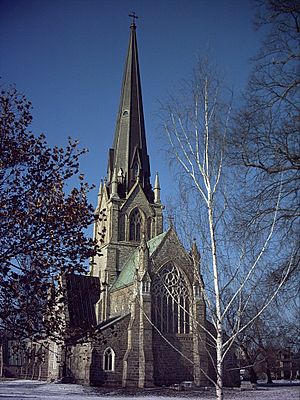
It's hard to know exactly how many English Canadians identify with specific religions. In 2001, the largest religious groups outside Quebec were Protestants (about 8.3 million) and Roman Catholics (about 7 million).
Many English Canadians also reported having no religious affiliation (about 4.5 million in 2001). Other religious groups include Orthodox Christian, Muslim, Jewish, Hindu, Sikh, and Buddhist.
While Protestantism is a large group, it is still a minority of the total English Canadian population. English Canadians include many people who are not Christian. Even among Christians, there is a wide variety of beliefs. This makes it hard to say that religion defines English Canadians.
Literature and Arts
Early Canadian literature in English often used humor. It was often ironic and self-deprecating. Writers like Thomas Chandler Haliburton and Stephen Leacock showed this.
Margaret Atwood's book Survival: A Thematic Guide to Canadian Literature (1973) says that Canadian literature often focuses on survival. This theme still appears in newer books. An example is Yann Martel's Life of Pi, which won the Booker Prize in 2002.
In the 1970s, authors like Margaret Laurence and Robertson Davies explored small-town life in Canada. Their books helped Canadians understand their own experiences.
In the early 1900s, Canadian painters started using new styles. Artists like Tom Thomson and the Group of Seven painted Canadian landscapes. They showed the wilderness in new ways. Emily Carr painted Indigenous villages on the Northwest Coast. Her art helped people appreciate First Nations cultures. The Arctic paintings of Lawren Harris are also very important to English Canadians. Cowboy artist Earl W. Bascom was known for his sculptures of cowboy life.
Heroes and National Stories
For some English Canadians, history starts with the first pioneers. The fur trade, run by the North West Company and Hudson's Bay Company, is also important. The resettlement of Loyalists after the American Revolution is another key part of their history. Some say the Loyalist story is a collective myth for English Canadians.
The War of 1812 created an early national hero: Laura Secord. She warned British troops about American plans. This helped win the Battle of Beaver Dams. The War of 1812 is seen as the event that ensured the survival of the colonies that became Canada.
Sir John A. Macdonald was Canada's first prime minister. He was a Scottish lawyer from Kingston, Ontario. Despite some challenges, he is admired for building the nation. Macdonald helped create the idea of Canada having "two founding nations" (English and French). This idea lasted for a long time.
Macdonald also helped found the North-West Mounted Police in 1875. This group later became the Royal Canadian Mounted Police (RCMP). The RCMP is Canada's famous national police force. It helped bring order to the West. The RCMP plays a role in how English Canada sees itself as a law-abiding nation.
The Klondike Gold Rush in 1898 in the Yukon also captured the imagination of English Canadians. It told stories of adventure in the harsh North. The idea of the North, with its tough landscape and climate, is central to English Canadians.
In the 1900s, Tommy Douglas became a hero. He was a politician from Saskatchewan. He is known for creating Canada's universal health care system. He was voted the "Greatest Canadian" in a contest. Lester B. Pearson, who won the Nobel Peace Prize, is also a key English Canadian figure. He was prime minister when the maple leaf flag was adopted.
Terry Fox had a huge impact on English Canadians. In 1981, he tried to run across Canada to raise money for cancer research. He had to stop his run, but he inspired millions. Rick Hansen later completed a similar journey in his wheelchair.
Sports heroes include Wayne Gretzky, who led the Edmonton Oilers to many Stanley Cup wins. The women's Olympic hockey team and Team Canada (who won the 1972 Canada-Russia hockey series) are also celebrated.
Rodeo is popular in Canada. Ray Knight is known as the "Father of Canadian Professional Rodeo." Earl W. Bascom is called the "Father of Modern Rodeo" for his inventions.
Other important figures include Nellie McClung (women's rights activist), Emily Carr (artist), and Dr. Frederick Banting (co-discoverer of insulin). Alexander Graham Bell, who invented the telephone, lived in Canada.
Historian Charlotte Gray says Canadians prefer to celebrate groups rather than individuals. She says Canadians value "tolerance" as a key national quality.
French-speaking Canadians have also greatly influenced English Canadian culture. Many Canadian symbols, like the maple leaf and beaver, were first used by French speakers. French-speaking sports figures are highly respected. Sir Wilfrid Laurier, a prime minister, is seen as an important statesman. Pierre Trudeau is a more debated figure. He is praised for his handling of the October Crisis and creating the Canadian Charter of Rights and Freedoms. But he also caused some unhappiness in Western Canada. He was ranked 3rd in "The Greatest Canadian" contest.
Canada's role in World War I and World War II helped shape its identity. After France fell in 1940, Canada saw itself as Britain's main ally against Adolf Hitler. The famous poem In Flanders Fields, written by John McCrae, is linked to Remembrance Day.
Popular Culture
The RCMP "Mountie" is a well-known symbol of Canada worldwide. In popular culture, Mounties are often shown as English-speaking. Examples include Dudley Do-Right and Benton Fraser. The idea of the heroic Canadian also appeared in comic books, like Johnny Canuck.
Anne of Green Gables by Lucy Maud Montgomery is one of English Canada's most famous contributions to popular culture. The humor and small-town life seen in Stephen Leacock's work continued in TV shows. These include The Beachcombers, Corner Gas, and Little Mosque on the Prairie.
Canadian humor also grew with shows like SCTV (especially the Great White North sketches), The Red Green Show, and Trailer Park Boys.
Traditional music in English-speaking Canada often comes from Scotland and Ireland. This music was brought to Newfoundland and the Maritime provinces. In recent years, artists from Cape Breton Island and Newfoundland have become very popular. These include Rita MacNeil, the Rankin Family, Natalie MacMaster, Ashley MacIsaac, and Great Big Sea. A Celtic influence is also found in music from other parts of Canada. Examples are Spirit of the West, Stan Rogers, and Loreena McKennitt.
See also
 In Spanish: Anglocanadienses para niños
In Spanish: Anglocanadienses para niños
- English-speaking Quebecers
- British North America
- Culture of Canada
- List of English Canadians
- British diaspora in Africa


